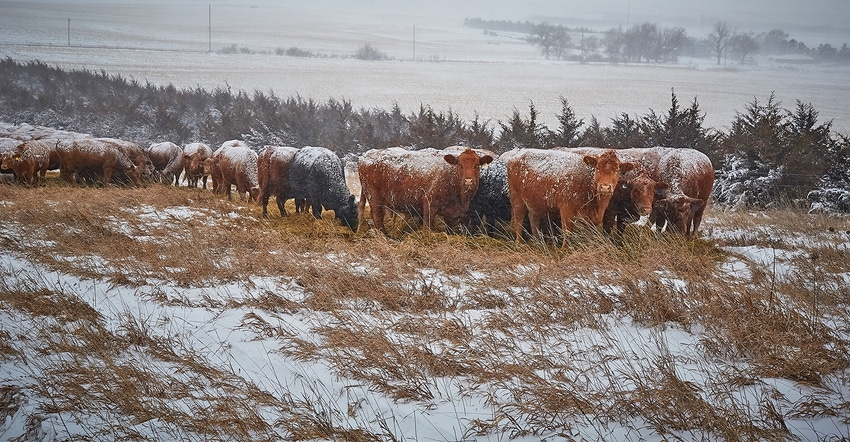November 26, 2019

While cattle can endure colder outdoor temperatures than humans can, winter bedding is ideal for desirable feed efficiency and growth performance.
Understanding the average core temperature of cattle and the thermoneutral zone can help producers make winter bedding decisions. The thermoneutral zone is a range of outdoor temperatures that cattle can endure without changing their core body temperature. When air temperatures are below the thermoneutral zone, heat loss from cattle occurs, decreasing cattle’s core body temperature. To keep a consistent core temperature, cattle must then metabolize body fat stores or redirect energy from feed consumed, costing the producer in additional feed costs and/or reduced feed efficiency.
The average core temperature of mature cattle is 101.5 degrees F, while their thermoneutral zone ranges from 32 to 77 degrees. A clean, dry, open winter coat on healthy, mature cattle traps air that acts as insulation. This additional insulation allows cattle’s thermoneutral zone to drop to 18 degrees.
Younger animals, such as calves and heifers, have a higher thermoneutral zone, as these animals typically have less fat content on their bodies. The lower limit on a calf’s thermoneutral zone can be as high as 50 degrees. Anytime temperatures drop below 50 degrees, additional bedding, feed and/or calf jackets should be provided.
Air and real-feel temperatures are rarely the same during Wisconsin winters. A 10-mph wind can cause an air temperature of 18 degrees to feel like 6 degrees, even to healthy, mature cattle with clean, dry hair coats.
In a North Dakota State University study, researchers concluded that providing modest wheat straw bedding, defined as enough bedding so animals did not have to lie on snow or frozen manure, to finishing steers increased average daily gain, gain-to-feed ratio, finishing weight, hot carcass weight, dressing percentage, marbling score and rib-eye area compared to finishing steers with no bedding. An additional group of finishing steers was provided with twice as much straw bedding per day compared to the modestly bedded steers. Both of those groups performed similarly.
Winter weather
Wisconsin snow cover can range from 65 to 140-plus days, depending on the year and region. Snow cover is not the only thing to consider when providing bedding. Cold, wet and muddy conditions that occur in the fall and spring increase the amount of bedding needed. Depending on individual farm management and facilities, it may be necessary to plan for 180 days of confinement bedding needs for beef cows and more than 180 days of confinement bedding for feedlot cattle. One rule of thumb is to plan for roughly 5 pounds of bedding per head per day; however, that can vary depending on weather, pen management and stocking density.
Adverse growing conditions have led to not only winter feed shortages but also winter bedding shortages. While cornstalks are the common winter bedding choice in Wisconsin, equal amounts of small-grain straw can be used. Additional winter bedding options include sand, shredded paper or sawdust. Each alternative has its pros and cons — producers should use the option that works best for them that provides a dry, warm environment for cattle.
The next time you head out to the barn on a winter day, check your current winter bedding. Providing adequate winter bedding can increase economic return in cattle.
Nelson has a doctorate in animal science and is the University of Wisconsin Extension livestock outreach program manager. This column is provided by UW-Extension’s Wisconsin Beef Information Center.
You May Also Like




